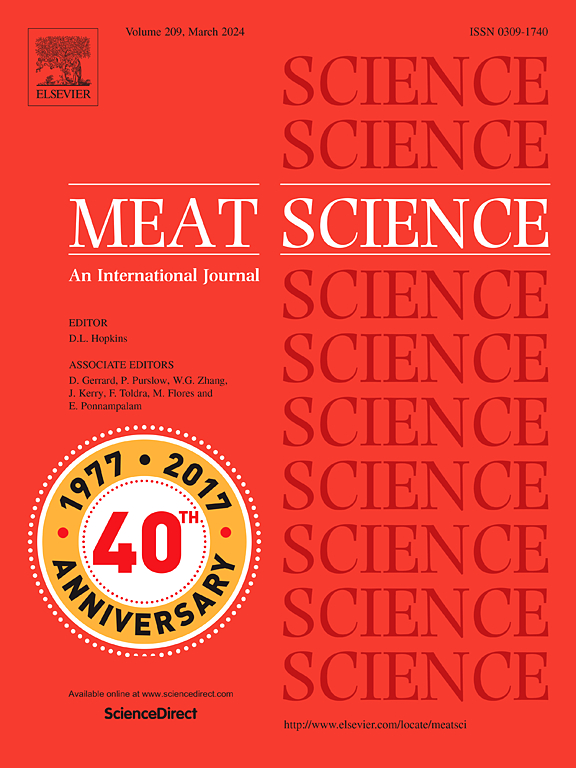免疫阉割的杜洛克杂交猪生长和育肥期的饲喂方案
IF 6.1
1区 农林科学
Q1 Agricultural and Biological Sciences
引用次数: 0
摘要
本试验旨在评价不同饲喂方案对杂交杜洛克猪生长和肥育期生产性能、胴体产量和肉品质的影响。我们选用免疫阉割的公母猪(IC)和由长白×大白杂交母猪与杜洛克末猪杂交而成的母母猪。试验动物分为2个性别组和3个摄食方案:自由摄食(AL)、摄食方案1 (FP1):摄食方案1 (FP1):摄食方案2 (FP2):摄食方案2 (FP2):摄食方案1(- 25%)。摄食系数(FCR)随摄食限制的增加而降低,且雄性比雌性好。限饲降低了日增重(DWG),导致屠宰年龄和肥育期天数增加。饲喂方案对热胴体重和冷胴体重均无显著影响。然而,饲喂方式和性别组对胴体产量(CY)有交互作用,雌性没有影响,但FP2雄性的CY低于AL雄性。但限饲对腰重和产量的影响较大(P <;0.05)。性别组显著影响(P <;0.05)胴体产量,雌性胴体产量较高,腿部、腹部、肋部和下颌等部位较重(P <;0.05)。饲养管理不影响肉质,但雌性表现出较高的大理石纹(P <;0.05)。综上所述,计划生育提高了IC公鱼的FCR,但降低了DWG。此外,雌性比雄性表现出更高的产量、更重的切口和更大的大理石纹。本文章由计算机程序翻译,如有差异,请以英文原文为准。
Feeding programs for immunocastrated male and female Duroc hybrid pigs in growing and finishing phases
The study aimed to evaluate the effects of different feeding programs (FP) on the performance, carcass yield, and meat quality of hybrid Duroc pigs during the growing and finishing phases. We used immunocastrated males (IC) and females crossbred from hybrid sows (Landrace × Large White) with Duroc terminal boars. The animals were distributed into two sex groups and three feeding programs: ad libitum feeding (AL), feeding program 1 (FP1): −15 % compared to AL, and feeding program 2 (FP2): −25 % compared to AL. The feed conversion ratio (FCR) decreased as the feed restriction increased, and it was better in IC males than females. Feed restriction reduced daily weight gain (DWG), leading to increased slaughter age and days in the finishing phase. The feeding programs did not influence hot carcass weight (HCW) or cold carcass weight (CCW). However, an interaction between feeding program and sex group was observed for carcass yield (CY), with no effect in females, but lower CY in FP2 males compared to AL males. However, loin weight and yield were affected by feed restriction, which was higher (P < 0.05) in FP1. The sex group significantly influenced (P < 0.05) carcass yield, with females showing higher yield and heavier cuts, such as leg, belly, rack, and jowl (P < 0.05). Feeding management did not affect meat quality, although females exhibited higher marbling (P < 0.05). We concluded that the feed restrictions imposed by the FP improved FCR in IC males but reduced DWG. Additionally, females showed higher yields, heavier cuts, and greater marbling than males.
求助全文
通过发布文献求助,成功后即可免费获取论文全文。
去求助
来源期刊

Meat Science
工程技术-食品科技
CiteScore
12.60
自引率
9.90%
发文量
282
审稿时长
60 days
期刊介绍:
The aim of Meat Science is to serve as a suitable platform for the dissemination of interdisciplinary and international knowledge on all factors influencing the properties of meat. While the journal primarily focuses on the flesh of mammals, contributions related to poultry will be considered if they enhance the overall understanding of the relationship between muscle nature and meat quality post mortem. Additionally, papers on large birds (e.g., emus, ostriches) as well as wild-captured mammals and crocodiles will be welcomed.
 求助内容:
求助内容: 应助结果提醒方式:
应助结果提醒方式:


